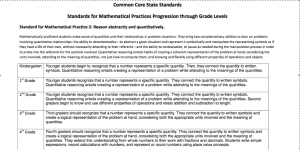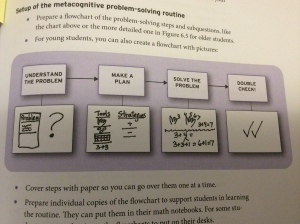E2 Exemplify collaboration within the school. Teacher candidate participates collaboratively and professionally in school activities and using appropriate and respectful verbal and written communication.
Last week in Elementary Math Methods class, the students participated in a peer teaching activity. Each peer was given 15 minutes to deliver his or her lesson. I chose to use the problem-solving format and used a Common Core State Standard based on counting and cardinality. The Math Practice used was helping students “recognize that a number represents a specific quantity” (source: Standards for Mathematical Practices Progression through Grade Levels, MP2).
The lesson was based on a primary elementary level and my peers could easily do the problems presented. Regardless, all of us were able to stay in character as the ‘Teacher’ and the ‘Students’. The overall pacing of the lesson went really well, and students helped by slowing down their work level and asking questions along the way. Peers were encouraged to work together and provide support for one another.
Our group discussed the learning target a number of times throughout the lesson. The learning targets were mentioned at least three times throughout the lesson. At the start and end of the lesson one of the peers read the learning target and at the end the peers were asked to reflect on how they did reaching that goal. Peers were also questioned about how they could put the learning target into their own words.
I received positive informative feedback from peers about my lesson and specifically about the reflection at the end of my lesson. One thing I would do differently is to give adequate time and encouragement to play with the manipulatives before the lesson. Letting students work with the manipulatives before the lesson accomplishes two things; first they get the ‘play time’ out of their system a bit and are more ready to listen and learn, second it gives them additional time working with them which may lead to increased comprehension and understanding of how a particular manipulative works.
This was also a great opportunity to watch and learn from my peers. I’ve known them almost a year now and it is always enjoyable to get to see their teacher persona. They each brought something different to their lesson. For example, one of my peers provided an additional resource by using an online book to demonstrate her concept. The other peer was great at displaying her work and explaining her thinking as she demonstrated the math concept to us. The time spent working through an actual lesson was valuable collaboration time as we worked to improve our presentations, transitions, and pacing.
The implications of having gone through this teaching experience are that I’m able to feel slightly more comfortable presenting in front of my peers. In my opinion it can be an awkward situation. This time however there was a comfort level there which made it easier for me to stick with my lesson and stay in my teacher persona.
The picture below is from the Common Core State Standards, Standards for Mathematical Practices Progression through Grade Level, Practice 2 Reason abstractly and quantitatively. For my recent peer lesson I chose a 1st grade Common Core State Standard and Math Practice.
References:
Common Core State Standards Mathematical Practice Progression through Grade Levels.

